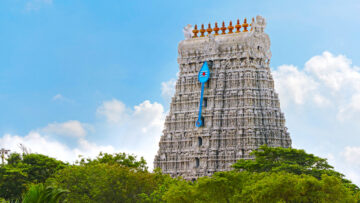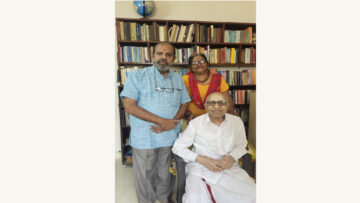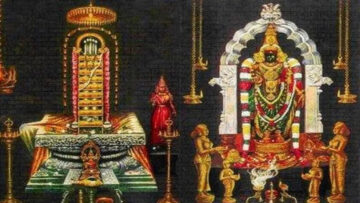Ekāmbareshwarar – Prithvi Tatva: The Stillness of Earth
“Before there was a temple or city, there was Earth—silent, weighty, eternal. In Kanchipuram, where time folds into myth, Shiva does not merely dwell; He becomes Earth itself. Not as symbol, but substance. Here, in the Ekāmbareshwarar Temple, the Lord is pṛthvī tattva—dense with devotion, ripened by Pārvati’s penance, and rooted in a soil that remembers gods.”
Among the five sacred Shiva temples known as the Pancha Bhoota Sthalams, representing the five primordial elements—Earth (Pṛthvī), Water (Āpas), Fire (Agni), Air (Vāyu), and Space (Ākāśa)—Ekāmbareshwarar Temple at Kanchipuram stands as the embodiment of Earth, the foundation of all that lives and endures.
In Shaiva cosmology and Āgamic tradition, Shiva is not worshipped as an abstract deity but revealed through the bhūtas themselves. These are not metaphors. They are tangible truths enshrined in sacred geography. At Kanchipuram, Shiva becomes pṛthvī tattva—solid, sustaining, and fertile. He is the very ground of being, and the altar of Pārvati’s devotion. As the Kanchi Mahatmya declares
कामाक्ष्या पश्चिमे देशे पृथि्वीस्थं महेश्वरम्।
एकाम्रनाथं वन्देऽहं भक्तानां कामदं प्रभुम्॥
Kāmākṣyāḥ paścime deśe pṛthivīsthaṁ Maheśvaram |
Ekāmranāthaṁ vande’ham bhaktānāṁ kāmadaṁ prabhum ||
“I bow to Ekāmranātha, the Lord who grants the desires of devotees, who resides in the Earth element to the west of Goddess Kāmākṣī.”
The Sacred Pattern of the Five Elements
Creation, in Shaiva thought, begins not with chaos, but with order arising from stillness. In the beginning, there was only silence—Shiva, unmanifest. Then came the first breath, and from it unfolded the five great elements:
Earth, the weight of form.
Water, the current of longing.
Fire, the leap of transformation.
Air, the whisper between breath and space.
Space, the vastness that contains all.
To remind us that divinity is not distant but embedded in the world, Shiva did not simply create these elements—He became them. Thus, were born the Pancha Bhoota Sthalams: five temples, five embodiments, five portals through which the seeker can re-enter the rhythm of creation.
These temples are not monuments. They are thresholds. To journey through them is to journey through the elements, and through the self.
My Journey Through Mātā, Pitā, Guru
When I began this pilgrimage, there was no fixed order in my mind. But slowly, devotion revealed a pattern: Mātā, Pitā, Guru.
At Chidambaram, my mother’s native place, I encountered the Ākāsha Lingam — Shiva as space, unseen yet all-pervading.
At Tiruvannamalai, my father’s land, I bowed before the Agni Lingam, where Shiva rises as fire, radiant and transformative.
And now, I have arrived at Kanchipuram, where I offer homage to Guru: Jagadguru Chandrasekharendra Saraswati Swamigal, known lovingly as Periyava. He was the 68th Shankaracharya of the Kanchi Kamakoti Peetham, and to me, he embodies pṛthvī tattva itself—grounded, silent, enduring.
Three temples. Three elements. Three roots of my becoming. Mātā, Pitā, Guru..
When the time is right, the fourth—Deivam—will call. Until then, I walk with what has already been given.
Before the Temple, the Guru
गुरु गोविंद दोऊ खड़े, काके लागूं पाय।
बलिहारी गुरु आपणे, गोविंद दियो बताय॥
Guru Govind douū khaṛe, kākē lāgū̃ pāya?
Balihārī guru āpaṇē, Govind diyo bataāya॥
“Guru and Govind (God) both stand before me—whose feet should I touch first?
I am forever indebted to my Guru, who showed me the path to Govind.”
Before speaking of the temple, I must pause at the mutt. For Kanchipuram is not only a city of temples—it is a city of transmission. Its soil holds not only shrines, but also grace. And in that grace walks the presence of Periyava. To many, he was Shiva in saffron — silent, barefoot, unwavering. Devotees speak of his gaze—how it stripped pretence, how it healed without touch. He lived simply, walked barefoot, read deeply, and remembered every soul who crossed his path.
Periyavaal — as Jagadguru Sri Chandrasekharendra Saraswati Swamigal is lovingly called — the ever-compassionate one, whose grace continues to guide countless devotees. His quiet presence, his deep tapasya, and his vast knowledge rooted in tradition have made him a timeless spiritual beacon. For many of us, he is the Guru — guide, mentor, inner compass.
After him, Sri Jayendra Saraswati, with his inclusive outlook and accessible presence, widened the circle. Then came Sri Vijayendra Saraswati, attuned to the demands of the times, articulate and clear in the narrative he weaves. And now, the present Bala Acharya, Sri Saisankara Vijayendra Saraswati, embodies serenity itself — shānta-swarūpi, a presence that stills the mind.
But even amidst this living lineage, it is Periyava who remains etched in our hearts — not just as a sage of rare brilliance, but as a living Guru, ever near, ever guiding. Even now, decades after his mahasamadhi, one feels his presence—not as memory, but as presence—in the rhythms of the mutt, in the dharma that endures.
(Figure 1: Periyava Śaraṇam – the still flame of Kāñchi, whose quiet gaze continues to guide.)
I offer this at the feet of the Guru. Periyava Śaraṇam.
Kanchipuram: Where Gods and Gurus Dwell
Some cities wear sanctity lightly. Kanchipuram does not. Here, divinity is not spoken—it is breathed. As one of the Sapta Moksha Puris, it is home to both Shiva and Vishnu in radiant harmony.
The spires of Ekāmbareshwarar, where Pārvati once shaped a mud linga beneath a mango tree, rise alongside the serene majesty of Varadaraja Perumal, who dwells in water and emerges rarely for darśan.
To speak of Kanchipuram is not to speak of a temple in isolation. It is to enter a sacred ecology, where stone, silence, and sagehood intertwine.
But no journey through Kanchipuram is complete without turning inward—to the source of power, the Shakti that animates all form, all knowledge, all devotion. For if Ekāmbareshwarar is the grounding stillness of Earth, then Kamākṣī is the luminous core from which that Earth draws life.
She is Lalitā Tripurasundarī, the Supreme Devi—not merely consort, but sovereign. Her name means She of the Loving Eyes, and yet, her gaze is no less than cosmic command. She does not dwell on a mountaintop or in a distant heaven. She reigns from the center of the city—Kāmakoṭi Pīṭha—seated in majestic stillness upon the Sri Chakra, the very yantra of creation itself.
Kamākṣī is not one among many goddesses. She is the One—who encompasses all forms of Śakti: Kālī, Durgā, Bhavānī, and more. Even in her quiet, she holds within her the terrible and the tender, the ascetic and the adorned.
Her temple is unlike others. There is no standing Devi here. Kamākṣī sits—seated in supreme yoga, eyes half-closed in stillness, holding sugarcane, flowers, a goad and a noose—symbols of desire, awakening, control, and surrender. Around her, silence pulses with an almost electric vibration. Every breath feels watched, every movement softened by her presence.
This is not just Devi as mother, but Devi as origin—the one from whom the five elements arise, into whom the five elements dissolve. Kanchipuram may be called the city of a thousand temples, but it is Kamākṣī who holds them all together—not as queen, but as axis.
She is Kāñchi’s heart, and in many ways, Kāñchi itself. And in this heart resides Ekambareshwarar.
(Figure 2: Kāmākṣī Ambāl – Eyes of compassion, hands of grace)
Legends of Devotion: The Sthala Purāṇam of Ekāmbareshwarar
The sanctity of Ekāmbareshwarar Temple is not simply carved in stone—it is lived in legend. At the heart of this temple’s lore lies a deeply intimate tale of devotion, testing, and divine reunion.
It is said that Pārvati, seeking union with Shiva, came to Kāñchipuram to perform penance. Under the shade of an ancient mango tree—the sthala vriksha still worshipped today—she fashioned a linga from the very soil of the earth, molding it with her own hands. There was no sculptor, no ceremonial consecration—only bhakti, breath, and mud.
(Figure 3: At Her feet, where all seeking comes to rest)
Moved by her devotion, Shiva decided to test her resolve. He caused the river Kāmpā to rise in sudden flood, threatening to wash away the fragile mud linga. Undeterred, Pārvati embraced the linga, shielding it with her body. Her surrender was total—not merely of body, but of ego, fear, and separation. The waters could not prevail.
Seeing her unwavering love, Shiva appeared, accepting her as his equal and consort. In that moment, Earth was not just an element—it became the medium of union between the devotee and the divine.
This is why the pṛthvi-linga remains uncarved and unanointed. To this day, no water or oil is poured upon it, lest the original mud form—shaped by the Goddess herself—be eroded. It stands untouched, alive with the energy of that first act of creation through surrender.
It is also believed that the divine couple were married here, in Kāñchi. Some versions even say that the other gods came to witness this sacred union, making the temple a site of not just elemental sanctity, but cosmic celebration.
The name Ekāmbareshwarar derives from three words: Eka (one), Amra (mango), and Īshwara (Lord)—meaning “Lord of the One Mango Tree.” It refers to the sacred mango tree under which Pārvati performed her penance and fashioned the mud linga. This Ekāmra Vṛksha, still thriving in the inner courtyard, is no ordinary tree. Its four limbs are believed to bear four distinct varieties of mangoes, symbolizing the four Vedas or the four yugas. It stands not only as witness but as participant in the myth.
In time, the city itself came to be called Ekāmranātha Kṣhetra—the field of the One Mango Tree—sanctified by the Goddess’s penance and Shiva’s appearance.
It is no coincidence that this temple is also one of the Pancha Aranya Sthalams—the five forest shrines of Shiva. Known as Māvaṛaṇyam, the Mango Forest, this site aligns with four other sacred groves: Mullai Vanam at Tirukkarugavur, Paadhiri Vanam at Avalivanallur, Vanni Vanam at Tirupugalur, and Erukku Vanam at Koilpatthu. In each, a particular tree or grove becomes the axis of divine presence, teaching us that nature itself is liturgy.
These temples symbolise the deep intertwining of nature, myth, and worship, where the tree becomes sanctum, the forest becomes mantra, and the Deity reveals Himself through the ecology itself. They’re often included in spiritual circuits undertaken by Shaivite pilgrims seeking both environmental and inner balance.
Thus, Ekāmbareshwarar stands not only as the Prithvi Sthala but also as a forest of wisdom, where the earth, tree, and temple are inseparable.
Other Legends and Sacred Associations
Though the legend of Pārvati’s penance is central, Ekāmbareshwarar Temple is a tapestry of many sacred threads:
Vishnu as Vāmana is believed to have worshipped Shiva here before his encounter with Mahabali. In gratitude, Shiva granted him darśan, adding to the temple’s Vaishnava links.
The river Kāmpā, which once surged to test Pārvati’s devotion, continues to be revered as sacred. Its waters are believed to cleanse not just the body, but karmic residue. The temple tank, known as Shiva Ganga, is said to have been created by Shiva himself to bless the temple and the Goddess.
These stories, while diverse in form, all circle back to the same center of gravity—the pṛthvī tattva, and the stillness of Shiva as Earth, waiting to receive the love that seeks him.
Even today, in the quiet shade of that ancient mango tree, one does not merely recall a legend—one feels it. The air carries her devotion, and the earth, his response. For this is not just myth, but a teaching—that life is held not by force, but by balance: between Śiva and Śakti, stillness and surrender, Pṛthvī and Prakṛti.
A Temple Rooted in Time, Text, and Tradition
What lives in legend also breathes through literature. The sanctity of Ekāmbareshwarar Temple is not only etched in stone or whispered beneath a mango tree—it pulses through centuries of verse, scripture, and sacred record.
In early Tamil devotional literature, this temple emerges with clarity and reverence. The Tēvāram hymns of the 7th to 9th centuries CE, sung by the Nayanmars—Appar, Sundarar, and Tirugnanasambandar—celebrate Ekāmbaranāthar, “the Lord of the Single Mango Tree.” These verses not only sanctify the deity but weave the sacred geography of Kanchipuram into Tamil Shaiva identity. It is no wonder then that Ekāmbareshwarar finds his place among the Pādal Petra Sthalams—temples hallowed by song.
By the 12th century, Sekkizhar’s Periya Puranam further embedded the temple in the devotional consciousness of Tamil Nadu, narrating how saints journeyed here—not for spectacle, but for surrender. Their lives, like Parvati’s, circled the same axis: Shiva.
The Puranas too, in Sanskritic tradition, affirm Ekāmbareshwarar’s stature. The Kanchipuram Māhātmya, nestled within the Shiva Purana and the Skanda Purana, tells of Parvati’s penance and Shiva’s trial by fire. When flames threatened her grove, it was Ganga, invoked by Parvati, who cooled the blaze. At last, Shiva appeared—not as wrath, but as grace. The site became not only a place of union but of elemental revelation—Pṛthvī-linga, Shiva as earth.
According to local Sthala Puranam, it was during a great flood that Parvati embraced the linga she had shaped, shielding it with her body and resolve. In doing so, she became one with him—and he became Ekāmbaranātha, “Lord of the Single Garment,” a name that evokes both renunciation and intimacy, simplicity and strength.
Thus, what began as mud beneath a mango tree is now layered in memory, music, mantra, and stone. Ekāmbareshwarar stands not merely as a deity enshrined, but as a presence lived—through devotion, legend, and lineage.
Architecture: Where Earth Becomes Form
If the prithvi-linga is the spiritual heart of Ekāmbareshwarar, then its architecture is the body—solid, enduring, and magnificent. In keeping with the element it represents, the temple doesn’t just sit on the earth—it is the earth, rising like a sacred mountain shaped by the devotion of generations.
Spread across more than 25 acres, the temple complex is one of the largest in South India. With intricate carvings of deities, celestial beings, and mythic motifs, its towering Rajagopuram, standing like a sentinel watching over the sacred city rising over 190 feet, invites the seeker inward—not just into the temple, but into the self.
One of the most revered features is the Athi Māru (Mango Tree), mentioned earlier, believed to be over 3,500 years old. With its four branches said to yield four different types of mangoes, this tree is no ordinary flora—it is a witness to eons of worship, myth, and transformation.
The temple’s thousand-pillared maṇḍapa is a testament to sculptural excellence and devotional geometry. Each pillar, carved with precision, echoes with silence rather than sound—reminding one that stillness is the truest form of speech. The inner prakara (circumambulatory path), shrines of consort deities, and the sacred tank (Shivaganga Teertham) complete the sanctified space, turning every corner into a meditative threshold.
(Figure 4: The Rajagopuram of Ekāmbareshwarar Temple—towering stillness in stone.)
This is not architecture for admiration alone—it is architecture for absorption. Every stone speaks. Every shadow remembers. Every doorway leads not just into halls, but into states of bhāva.
It features five concentric prakarams (enclosures), guiding pilgrims progressively inward toward the heart—the prithvi-linga.
The sanctum’s outer walls (koshtas) house standard Shaiva icons: Gan̩eśa, Dakṣiṇāmūrti, Brahmā, Viṣṇu, Durga, and Liṅgōdbhava — later restored or maintained to preserve architectural sanctity.
Garbhagṛha faces east and houses the raw mud pṛthvi-linga sculpted by Pārvati herself. Nearby, the shrine of Nilathingal Thundam Perumal (a Divya Desam Vishnu shrine) aligns westward, affirming Kanchi’s blended Shaiva–Vaishnava heritage
Every structure here resonates with Pṛthvī:
The massive gopuram, rising like a mountain.
The thousand-pillared hall, supporting not just roof but ritual space.
The koshta statues, embedded in wall, symbolizing cosmic forces guarding the sanctum.
The raw clay linga, untouched by ablutions, bearing the imprint of divine feminine devotion.
And the ancient mango tree, witnessing centuries of love, test, and transcendence.
This is not architecture for admiration—it’s architecture for immersion. Enter here not as an observer, but as a participant. Let every stone ground you in devotion, every corridor lead you inward, every pillar teach you the stillness that precedes creation.
Dynasties and Devotion: The Making of Ekāmbareshwarar
The grandeur of Ekāmbareshwarar Temple is not the work of one age or ruler—it is the layered legacy of many dynasties whose vision transcended brick and stone.
The Pallavas (6th–9th century CE) were among the earliest patrons. They laid the foundational structures and established Kanchipuram as a major Shaiva center.
The Cholas (9th–13th century CE), renowned for their architectural innovation and deep devotion, enriched the temple with inscriptions, endowments, and bronze icons.
The Vijayanagara Empire (14th–17th century CE), especially during the reign of Krishna Devaraya, gave Ekāmbareshwarar its towering gopuram, ornate halls like the Aayiram Kaal Mandapam (thousand-pillared hall), and enhanced the ritual and festival calendar with royal patronage.
The Nayaks, as later stewards, preserved and refined the iconographic and Agamic traditions.
Inscriptions across the temple walls reveal a vivid chronicle—of land grants, trade guilds, musical troupes, and festivals—all tied to the pulse of this temple-town relationship.
Each era did not merely renovate—it reimagined the sacred, adapting to the needs of its people while preserving the elemental sanctity of the pṛthvi-linga.
A Living Cultural Landscape: Kāñchi Beyond the Sanctum
Kanchipuram is not a frozen heritage site—it is a living, breathing confluence of devotion, economy, and culture, centered around its temples.
In traditional Indian town planning, the temple was never an isolated monument—it was the spiritual and economic heart. Markets, schools, music halls, granaries, and even irrigation systems were designed around it. Ekāmbareshwarar follows this model, anchoring not just spiritual life, but daily livelihoods.
Kāñchi’s famed silk weaving industry, producing exquisite sarees, grew in tandem with temple patronage. Families of weavers traditionally wove ceremonial clothes for deities and priests, and their patterns were inspired by temple motifs—lotuses, gopurams, koshta deities.
(Figure 5: Silk stories in colour—threads of Kanchipuram tradition)
Sculptors, bronze casters, oil pressers, garland makers, and temple cooks all sustained their craft through this ecosystem. Even today, many families trace their trade or service to temple-linked vocations passed through generations.
The daily and annual rituals at Ekāmbareshwarar—pujas, utsavams, music recitals, processions—are not reenactments of the past. They are unbroken traditions, renewing the city’s cultural vitality even in modern times.
Festivals and Rhythms of Devotion: The Pulse of Ekāmbareshwarar
At Ekāmbareshwarar Temple, time does not merely pass—it turns sacred. The cycle of festivals, rituals, and recitations are not events—they are renewals of cosmic order and collective memory.
Among the most significant festivals here is Pānguni Uthiram, celebrated in the Tamil month of Panguni (March–April), when the celestial wedding (kalyāṇam) of Shiva and Pārvati is reenacted with grandeur.
The utsava mūrti (processional deities) of Ekāmbareshwarar and Kāmākshi are brought together in a vibrant procession of love and union, cheered by devotees lining the streets.
The marriage ritual performed beneath the sacred mango tree echoes the original act of surrender and acceptance, commemorating the moment Parvati’s penance bore fruit. This festival is not just ritualistic enactment; it is collective renewal—a reminder that divine union is the ultimate harmony, and that the world, like the temple, rests on balance and mutual grace.
On Mahā Śivarātri, the temple remains open through the night. The sanctum becomes a still point around which the city breathes slowly and reverently.
Four kalās (quarters of the night) are marked with abhishekams (ritual bathing of the deity), Tevaram chanting, and the rising notes of nādhaswaram. It is believed that on this night, Shiva revealed his formless nature as the linga of light—resonating deeply in this prithvi sthala where that infinite presence is earthed into clay.
Throughout the year, the rhythms of the lunar and solar calendar fill the temple with life: Aadi Pooram (July–August) marks divine femininity, when Kamakshi is celebrated. Vinayaka Chaturthi brings vibrant pujas for Ganesha, whose shrines grace the temple corners. Every Pradosham—twice a month—is a moment of alignment, when Shiva is believed to open his heart to devotees. The temple glows with lamps, music, and mantras.
Ekāmbareshwarar Temple does not only stand in stone—it sings.
Every morning and evening, Tevaram hymns composed by Appar, Sambandar, and Sundarar are recited by Oduvars, keeping alive an oral tradition that spans centuries.
The Nāgaswaram and Tavil—ancient wind and percussion instruments—resound through the mandapas, echoing the elemental vibration of Earth itself. The thousand-pillared maṇḍapa, built with both spiritual and acoustic precision, becomes a venue for classical concerts during festivals, bridging temple and stage, devotion and artistry.
In Kāñchi, the arts are not entertainment—they are offerings. Music becomes prayer, dance becomes invocation, and even silence becomes mantra.
A Journey Through the Elements, A Journey Into the Self
Each of the Pancha Bhoota Sthalams offered not just a glimpse of the divine—but a mirror to the self. Not all learning came in silence; not all surrender was easy. But through every shrine, the elements became more than cosmic principles—they became inner companions, teaching me how to live, how to seek, how to be.
Chidambaram taught me that sky is not the limit. In the Ākāsha Lingam, I found the courage to unlearn boundaries and let the unseen guide me.
Tiruvannamalai dissolved what I thought I was. The Agni Lingam scorched away the ego that clung to definitions. I’m still learning. The walk is fire.
Kanchipuram grounded me. In the stillness of the Prithvi Lingam, I discovered that not all transformation comes in flames—some comes in rooting, in endurance, in simply staying the course.
Here, Pārvatī’s penance whispered a different strength: not conquest, but devotion; not striving, but surrender.
She did not fight the flood—she embraced the linga. And Shiva appeared.
These temples are not mere destinations. They are invitations—to lose ourselves, and to find something deeper.
In a world that teaches us to rise, these sthālas taught me the grace of bowing.
To the sky. To the flame. To the earth beneath my feet.
Pṛthvī is not movement. It is abiding.
It is Her—Parvati—who taught me this. In her soft persistence, in her quiet penance beneath the mango tree, I saw that devotion is not noise—it is nearness.
And He, who responded not with thunder, but with stillness, reminds me that strength does not always raise its voice. Sometimes, it simply remains.
To walk this path is to walk between them—Śakti and Śiva, Prakṛti and Pṛthvī—not as opposites, but as one wholeness. And that is the lesson of Ekāmbareshwarar.
I do not know where the fourth element will lead me, or when the fifth will call. But I walk steadier now, because Kanchipuram showed me:
One does not always have to walk through fire.
Sometimes, one just needs to stand.
Like earth.
Like love.
Like Pārvatī.
This journey is for Her—
Who shaped the linga with her own hands,
Who did not resist the flood,
But chose love over fear.
And for Him,
Who appeared not in might,
But in response.
And for the one who walked in silence,
Whose gaze turned earth into shrine—
Periyava, whose stillness steadied my own.
To the Mother, the Father, the Guru, and the One beyond form… this offering is made.
And so I bow—to Her who remains, silent and steadfast, in the earth She once embraced.
या देवी सर्वभूतेषु श्रद्धारूपेण संस्थिता ।
नमस्तस्यै नमस्तस्यै नमस्तस्यै नमो नमः ॥
Yā Devī Sarvabhūteṣu Śraddhārūpeṇa Sansthitā
Namastasyai Namastasyai Namastasyai Namo Namaḥ
“To that Devi who abides in all beings as devotion itself,
I bow again and again and again.”
References and Further Reading
Skanda Purāṇa – Kanchipuram Māhātmya (English Translations and Sanskrit Editions)
Shiva Mahāpurāṇa – Sections on the Pancha Bhoota Sthalams
Sekkizhar. Periya Purāṇam. Translated by G. Vanmikanathan, Tamil Nadu Textbook Corporation.
Dehejia, Vidya. Slaves of the Lord: The Path of the Tamil Saints. Munshiram Manoharlal Publishers, 1988.
Peterson, Indira Viswanathan. Poems to Śiva: The Hymns of the Tamil Saints. Princeton University Press, 1989.
Website: https://greenmesg.org/stotras/durga/shakti_peethas.php
Website: Tamil Virtual Academy and Project Madurai (for Tevaram and classical Tamil texts)
Note: These sources have been engaged through a combination of reading, translation, commentary, and lived tradition. They are offered here not as an exhaustive bibliography, but as guiding lights along a devotional and experiential path.
Feature Image Credit: istockphoto.com
Disclaimer: The opinions expressed in this article belong to the author. Indic Today is neither responsible nor liable for the accuracy, completeness, suitability, or validity of any information in the article.
















